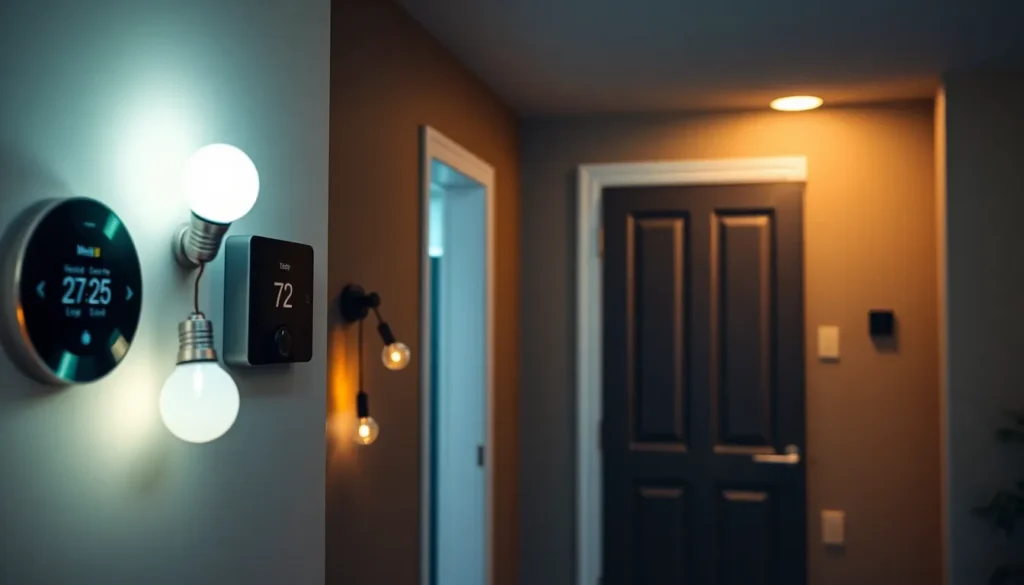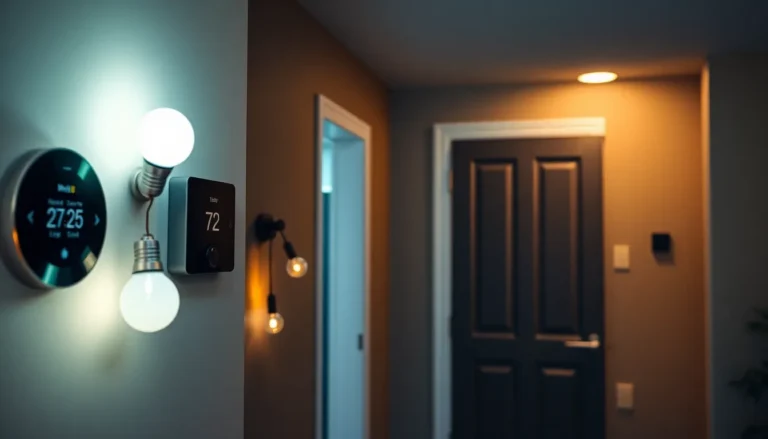In a world where smart devices are taking over homes faster than you can say “IoT,” the Zigbee protocol stands out like a superhero in a sea of gadgets. This low-power, wireless communication standard is the unsung hero behind seamless connectivity, making it easier for devices to chat without draining your battery faster than a toddler at a candy store.
Imagine a universe where your smart lights, thermostats, and security systems all work together in perfect harmony. That’s the magic of Zigbee. It’s not just about connecting devices; it’s about creating a smart ecosystem that’s efficient, reliable, and surprisingly easy to implement. If you’re ready to dive into the world of smart technology, understanding Zigbee could be your first step toward a more connected and energy-efficient lifestyle.
Table of Contents
ToggleOverview of Zigbee Protocol
Zigbee protocol operates as a low-power, wireless communication standard designed for various smart devices. It supports mesh networking, allowing devices to communicate with one another, significantly increasing range and reliability. Users benefit from its compatibility with a wide array of devices, including lights, sensors, and appliances.
Operating in the 2.4 GHz frequency band, Zigbee offers an effective solution for residential and commercial automation. One major advantage lies in its power efficiency, enabling devices to run for years on small batteries. A typical Zigbee network can support up to 65,000 devices, making it suitable for large installations.
In terms of security, Zigbee employs AES-128 encryption, ensuring secure communication between devices. Manufacturers prioritize interoperability, leading to the development of devices that can work together seamlessly. This capability enhances user experience, as individuals can easily integrate devices from different brands into one ecosystem.
Developers appreciate Zigbee’s simple implementation process. Its open standard encourages innovation, supporting diverse applications across smart home technology. Zigbee’s protocol stack is adaptable, promoting efficient data transmission even in crowded environments.
Due to its robust features, Zigbee has gained traction in smart city initiatives. Cities utilize its capabilities for applications such as smart lighting, environmental monitoring, and automated infrastructure management. Consequently, Zigbee remains at the forefront of creating interconnected environments.
Experts recommend understanding the benefits and applications of Zigbee for those interested in smart technology. Awareness of its capabilities can facilitate better choices when developing or enhancing smart homes. Embracing Zigbee contributes to a more efficient and connected lifestyle.
Features of Zigbee Protocol

Zigbee protocol offers several key features that enhance its functionality in smart home technology. Among these are its low power consumption and mesh networking capabilities.
Low Power Consumption
Zigbee protocols prioritize efficiency, allowing devices to operate on minimal power. Small batteries sustain these devices for years, significantly reducing maintenance needs. In fact, many devices remain functional for over five years on just a couple of AA batteries. Devices use sleep modes that conserve energy when inactive. This approach leads to reduced energy costs and aligns with the growing demand for sustainable technology. It’s crucial for homeowners looking to optimize energy use without sacrificing connectivity.
Mesh Networking Capabilities
Mesh networking stands out as a fundamental feature of Zigbee. This capability allows devices to communicate directly with one another. Each device in the network serves as a repeater, extending the overall range effectively. A typical Zigbee network can support up to 65,000 devices, making it suitable for extensive smart setups. Robust connections improve reliability by maintaining communication even when some devices are out of range. This means users enjoy a seamless experience, with devices working together harmoniously without signal interference.
Applications of Zigbee Protocol
Zigbee protocol serves various applications, enhancing connectivity in diverse environments. Its efficient communication capabilities make it a preferred choice in smart home automation and industrial control systems.
Home Automation
Home automation benefits significantly from Zigbee protocol. Devices like smart light bulbs, thermostats, and locks utilize Zigbee for efficient communication. A Zigbee-enabled smart home ecosystem allows for seamless integration, even with devices from different brands. Users enjoy the convenience of controlling multiple devices through a single app or voice command. The low power consumption means many devices run for years on small batteries, reducing maintenance demands. This technology enhances energy efficiency and improves comfort in daily living. Zigbee’s mesh networking optimizes coverage, allowing devices to communicate over longer distances and ensuring reliable operation throughout the home.
Industrial Control
Zigbee protocol plays a vital role in industrial control environments. Factories and warehouses leverage its capabilities for monitoring and managing equipment. Zigbee allows for real-time data transmission, facilitating effective decision-making processes. Sensors and actuators communicate via Zigbee, leading to enhanced automation and operational efficiency. The ability to connect numerous devices expands monitoring options, creating smart industrial applications. Moreover, the protocol’s robustness ensures reliable communication, even in complex setups which involve numerous devices. Zigbee’s secure encryption features also protect sensitive data, making it an ideal choice for industries concerned with security and efficiency.
Advantages of Zigbee Protocol
Zigbee protocol offers significant advantages in smart home and industrial settings. Its mesh networking capability enhances coverage and reliability, allowing devices to communicate over longer distances. Each device can act as a repeater, contributing to a robust network structure.
Low power consumption stands out as a key benefit. Many Zigbee devices operate efficiently for years on minimal battery power, often exceeding five years on just a couple of AA batteries. This efficiency minimizes maintenance efforts and supports sustainable technology initiatives.
Security features also play a vital role. Zigbee employs AES-128 encryption, providing a secure communication channel for sensitive data. Strong security assurances promote confidence in its usage across various applications.
Interoperability among devices ranks highly among users’ preferences. Zigbee allows products from different manufacturers to integrate seamlessly, fostering a diverse ecosystem. This versatility encourages innovation, attracting developers to create unique smart home solutions.
Scalability is another notable advantage. A typical Zigbee network supports up to 65,000 devices, making it suitable for expansive installations such as smart cities. Large-scale applications benefit from reliable communication even when some devices are out of range.
Energy efficiency and the potential for automated control enhance user experiences. Zigbee enables easy management of numerous devices through a single app or voice command. In both home and industrial environments, it streamlines operations while promoting a connected lifestyle.
Versatile applications extend to smart city initiatives, improving urban infrastructure management. Environmental monitoring, smart lighting, and automation are made efficient with Zigbee’s capabilities. These advantages position Zigbee as a leading choice for modern connectivity solutions.
Limitations of Zigbee Protocol
Zigbee protocols exhibit certain limitations that users should consider. One significant drawback is the range limitation, which, despite mesh networking, typically extends to about 10 to 100 meters, depending on environmental factors. Large homes or commercial spaces might experience coverage issues, requiring additional devices to maintain connectivity.
Moreover, Zigbee operates in the crowded 2.4 GHz frequency band, leading to potential interference from Wi-Fi networks, microwaves, and other devices sharing the same spectrum. Such interference may degrade communication quality, affecting the reliability of connected devices.
Latency also presents a challenge. Although generally low, it can increase with network complexity and the number of devices. Real-time applications, such as security systems, may not function optimally under these conditions.
Limited data transmission rates, reaching around 250 kbps, restrict the amount of information Zigbee can handle simultaneously. Consequently, this limitation affects applications that demand high-speed data transfers, like video streaming or large sensor deployments.
Another limitation involves device compatibility. While Zigbee promotes interoperability across devices from different manufacturers, not all products utilize the same versions. This inconsistency can complicate integration within a single network, creating frustration for users trying to mix and match smart home devices.
Lastly, security remains a concern. Although Zigbee employs AES-128 encryption for secure communication, any vulnerabilities discovered could expose devices to unauthorized access. Users must remain vigilant about security protocols to ensure the safety of their systems.
Zigbee stands out as a vital component in the realm of smart technology. Its low-power, wireless communication capabilities make it an ideal choice for both home and industrial applications. By enabling seamless device connectivity through mesh networking, Zigbee enhances reliability and coverage, catering to the growing demand for smart solutions.
While it offers impressive features like energy efficiency and secure communication, users should remain aware of its limitations, such as range and potential interference. Understanding these factors allows individuals to harness Zigbee’s strengths effectively. As smart technology continues to evolve, Zigbee’s role in creating interconnected ecosystems will undoubtedly expand, paving the way for smarter living and improved automation.










